Research Article - (2015) Volume 23, Issue 4
College of applied medical sciences, King Khalid University, Saudi Arabia
Alfarabi colleges, Nursing Department, Saudi Arabia
Jamal Saleh Al Wakeel
Department of Medicine, King Saud University, Riyad Saudi Arabia
Physical functioning declines over time with dialysis therapy. In hemodialysis (HD) patients, exercise has been established as a vital part of health promotion activities to improve all aspects of quality of life. Methods: A quasi-experimental intervention design was used, with pre and post assessments of the effects of implementation of an exercise program for hemodialysis patients at Mohail General Hospital in southern Saudi Arabia. Questionnaires were used to collect the following data: Physical Fitness Measurement, KDQoL-SFTM 1.3, Borg's 15-point scale for rating of perceived exertion (RPE), vital signs, and lab investigation of hemoglobin, serum phosphates, serum albumin, creatinine, fasting blood sugar, Kt/v, and urea.
Results: In the pre and post physical fitness scale as assessed by patients, there were statistically significant changes to the scores of all activities (p<0.001). Regarding the correlations between pre and post-program quality of life (QOL), scores indicate weak to strong statistically significant positive correlations in all domains except for those of cognitive function, quality of social interaction, and sleep. Moreover the patients’ Borg scores showed statistically significant decreases throughout the three months of follow-up (p<0.001). In addition, there were improvements in the adequacy of dialysis (kt/v) and in serum potassium levels (p<0.001) from the first to the third months. Although the percentages of patients with hemoglobin level 11 gm/dl or higher increased from 41.1% in the first month to 60.3% in the third month, the difference was not statistical significance (p=0.067).
Conclusions: The implementation of the exercise program was associated with significant improvements in the scores of all domains of quality of life and the physical fitness scale. Therefore, we suggest the exercise program might be applied in other similar situations such as with peritoneal dialysis patients so the effects can be evaluated for further improvement.
Exercise Program, HD, QOL, physical fitness and Saudi Arabia.
Activity intolerance is a very important predictor of mortality in patients with chronic kidney disease (CKD), and is associated with poor physical functioning compared to populations without kidney disease.[1]
Exercise is a physical activity defined as a planned, structured, and repetitive bodily movement done to improve mental and physical functioning and quality of life. The barriers faced by patients on maintenance hemodialysis therapy include fatigue, decreased motivation and the inability to schedule exercise around daily activities and dialysis schedules.[2]
The National Kidney Foundation (NKF) recommends physical activity for patients on dialysis therapy with a goal of 30 minutes of moderate intensity activity on most days if not all. [3]White & Grenyer reported that exercise has been established as a vital part of health improvement activities for all, especially those on dialysis therapy. Short term exercise programs show varying results depending on the extent of fatigue, quality of life, and the burden of the disease.[4] Fortunately, exercise training is beneficial for hemodialysis patients, but the benefits vary depending on the patient’s abilities and willingness to participate.[5]
The most recent relevant study demonstrates the positive impact of a dialysis exercise program on patients' physical functions.[6] Furthermore, optimal dialysis therapy would include many parameters addressed by clinicians such as haemodynamic stability, residual renal function, nutrition, blood pressure, volume control, inflammatory markers, nutrition, albuminaemia and mineral metabolism.[7] Unfortunately, muscle wasting, abnormalities in muscle function, and effects on exercise performance are common in patients with ESRD.[8] An interventional study done by Kouidi, et al reported that hemodialysis patients who adhered to long term exercise programs on non dialysis days showed considerable improvement in physical fitness and health.[9]
The Saudi Center for Organ Transplantation (SCOT) annual report 2012 highlights the present status of renal replacement therapy in the Kingdom of Saudi Arabia; and reported that there are presently 177 dialysis centers with 4481 machines catering to 12,116 patients.[10]
Unfortunately there are obstacles to implement exercise programs for hemodialysis patients.[5] With greatest challenge being to maintain an exercise culture'.[11] Because exercise is considered as a vital component to improve quality of life, especially in those with dialysis therapy, we identified in this current study the benefits of an Interdiayltic Exercise Programme on Quality of Life for haemodialysis patients in Saudi Arabia.
The aim of this study was to improve the quality of life and physical fitness of patients on maintenance hemodialysis therapy.
Study design and setting:
A quasi-experimental intervention design was used, with pre and post assessments for effectiveness, to implement exercise programs for hemodialysis patients at Mohail General Hospitalsouthern Saudi Arabia.
Subjects
A convenient sample of 73 adult patients attending the dialysis unit of Mohail General Hospital during the study period were recruited in the study with the following inclusion and exclusion criteria.
Inclusion criteria; aged greater than 18 and less than 85 years, both sexes, on maintenance hemodialysis therapy for at least three-months and willing to participate in the study and attend all programs.
Exclusion criteria: subjects will be excluded if they have unstable angina, lower limb amputation, or if they already meet or exceed the Borg Rating of Perceived Exertion authors’ recommendation of 90 minutes of heavy (15) intensity physical activity for two consecutive weeks. Subject will be excluded if he/she is admitted to hospital for more than 15 days for medical reasons.
Data collection
Study Variables
• Background: age, sex, work status, level of education, marital status, duration of dialysis, and the main caregiver characteristics.
• Clinical finding characteristics: vital signs, blood flow, duration of sessions, and laboratory tests results.
• The Borg Rating of Perceived Exertion
• Measurements of physical fitness.
• KDQoL-SF of the patient.
Tools of Data Collection: Structured interview questionnaire form: This tool was used to collect background data about patients and caregivers.
• Laboratory tests: hemoglobin, serum phosphates, serum albumin, creatinine, fasting blood sugar, Kt/v, and Urea).
• Daily dialysis session sheet: this sheet was used to collect the number of dialysis sessions, weight gain before and after sessions, dry weight, blood pressure and pulse (before exercise session, first 10 minutes of the session, second 10 minutes, and after the exercise session), duration of dialysis sessions, blood flow and complications during dialysis session, such as vomiting, nausea, dizziness, confusion, headaches, shortness of breath, muscle cramps, skin rashes, itching, chest pain, dry mouth, abdominal colic and other side-effects.
• Borg's 15-point scale for rating of perceived exertion (RPE) :
• The Borg Scale (Borg 1982) is a simple method of rating perceived exertion (RPE) and an important tool for self monitoring to detect the level of intensity in training and competition. Perceived exertion is an individual's rating of exercise intensity, formed by assessing their body's physical signs such as heart rate, breathing rate and perspiration/sweating.[12]
• Physical Fitness Measurement (Appendix V): used to measure patients' physical fitness before and after exercise programs. The components of the exercise program are a 30-second chair, arm curl, chair sit and reach, 8-foot up and go, back scratch and two minute step test.[13]
• The Kidney Diseases Quality of Life Short Form (KDQoL-SFTM 1.3): disease targeted items focus on particular health-related concerns of individuals with kidney disease and on dialysis[14]: Symptom/problems (12 items), Effect of kidney disease on daily life (8 items). Burden of kidney disease (4 items), work status (2 items), cognitive function (3 items), quality of social interaction (3 items), sexual function (2 items), and sleep (4 items), dialysis staff encouragement (2 items), and patient satisfaction (1 item). The KDQOL-SF TM 1.3 also includes a 36-item health survey as the generic core consisting of eight multi-item measures of physical and mental health status: physical functioning (10 items), role limitations caused by physical health problems (4 items), role limitations caused by emotional health problems (3 items), social functioning (2 items), emotional wellbeing (5 items), pain (2 items), energy/fatigue (4 items), and general health perception (5 items).[14]
Preparatory phase: During this phase, the researcher worked on explaining the exercise program to the patients and to the nursing staff and distributed booklets containing the physical fitness steps and details of the exercise program in Arabic with pictures so the process could be easily understood by the patient. Once the patients were ready to start the program, researchers collected KDQoL-SF and physical fitness information before the program started. The exercise program total duration was thirty minutes divided into 10 minutes before the session and 20 minutes during the session. Exercises included stationary bikes on the bed, rubber balls and upper and lower body resistance exercises with dumbbells and sandbags; three times a week.
Field-work: The researcher collected baseline data using interviewing techniques daily coinciding with the three shifts of work. Three to five patients were interviewed per day. The interview took between 30 and 40 minutes for each patient. After collecting the KDQOL-SF questionnaire and measuring physical fitness, the exercise program was applied to participating patients. After 8 weeks, the process of data collection was repeated to assess the impact of the exercise program. The total fieldwork lasted for about six months from February to August 2012.
Human rights: The researcher approached patients individually at the time of dialysis sessions, explaining the purpose of the study, and the importance of the exercise program in kidney disease and dialysis. Patients who were willing to participate were included in the study after obtaining their verbal consent.
Limitations of the study: The tools were lengthy, and sometimes needed more than one meeting with the patient.
• Patients started the program and then after 2 weeks, stopped training without giving any rational.
• Some patients traveled outside the region area or were admitted to hospital.
Formal letters were issued from the Faculty of Applied Medical Sciences, including ethical committee approval, and a letter from the deanship of the research center at King Khalid University to the medical director of the study settings. The researcher met with patients and explained the aim and the process of the study. Patient's verbal consents were obtained. Complete confidentiality of any obtained information was ensured. The researcher also assured the administration that the study would not affect the work in the study settings. The results of the study will be provided to the hospitals' authorities to maximize its benefits.
Statistical analysis was done using SPSS 18.0 statistical software packages. Data was presented using descriptive statistics in the form of frequencies and percentages for qualitative variables, and means and standard deviations for quantitative variables. Quantitative continuous data was compared using student t-tests in case of comparisons between two groups. Paired t-tests were used for prepost comparisons of the same patients. Pearson correlation analysis was used for assessment of the inter-relationships among quantitative variables, and Spearman rank correlation for ranked variables.
This study involved 73 patients on hemodialysis. The sample has slightly more males (56.2%), with ages ranging between 22 and 86 years, median 51 years as shown in Table 1. The majority of the patients are married (74.0%), not working (83.6%), and their education was mostly reading and writing (52.1%) or primary (26.0%).
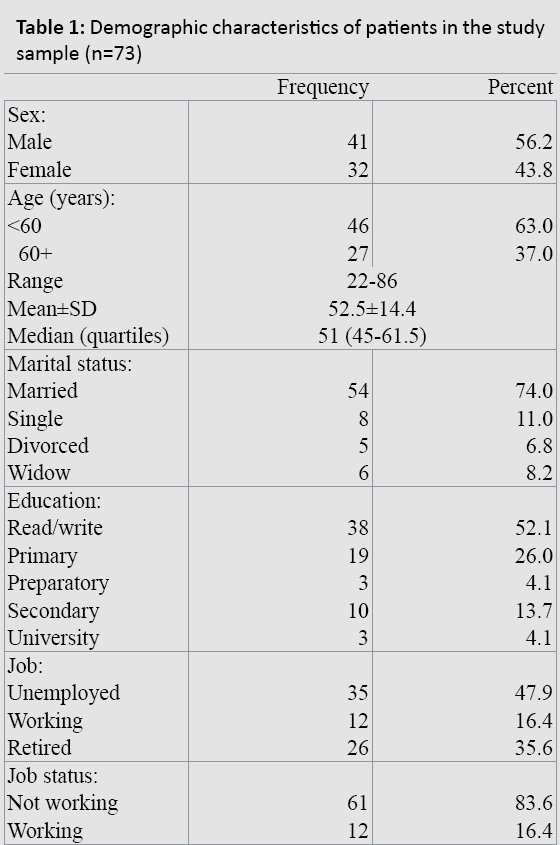
Figure 1 illustrates that patients’ children are the most commonly reported caregivers (42.5%). Meanwhile, 8 (11.0%) patients were caring for themselves.
According to Table 2, the majority of the patients have a fistula connection (86.3%). The duration of dialysis ranges between 3 and 170 months, with a median of 38 months.
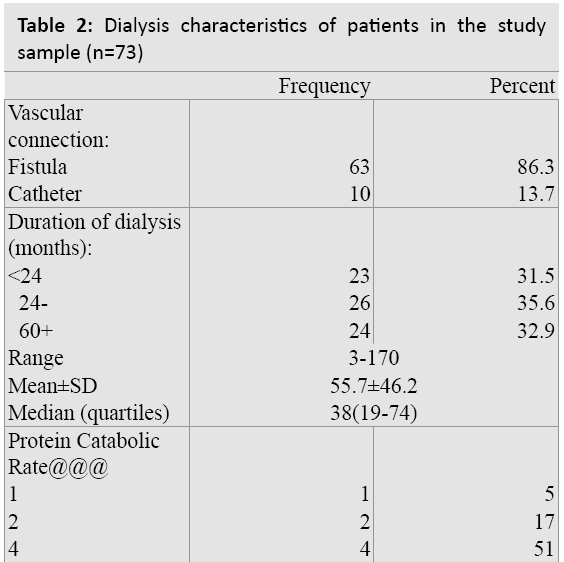
Table 3 describes the pre-post physical fitness scale as assessed among patients in the study sample. It points to statistically significant changes in the scores of all activities (p<0.001). The scores of chair, arm curl and 2-minute step test increased at the post-test, while those of the chair sit and reach, 8-foot up and go, and back scratch tests decreased. These changes indicate improvements. The table also demonstrates statistically significant positive moderate to strong correlations between the pre and post scores, reaching 0.90 for the back scratch test.
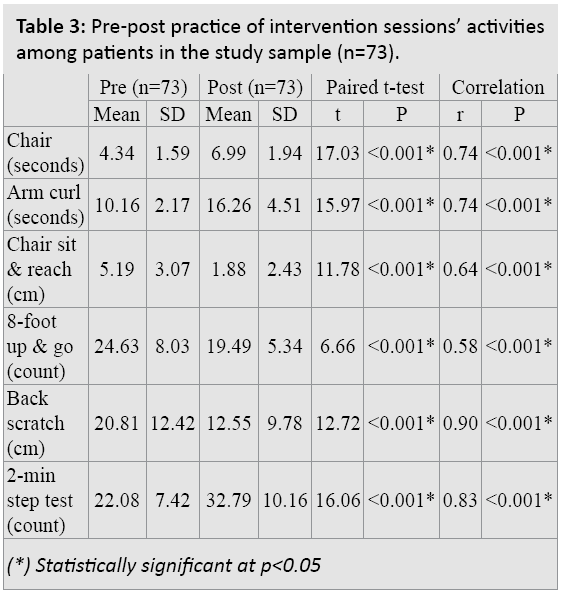
Table 4 describes the pre-post program scores of quality of life (QOL) as ESRD- related issues assessed among patients in the study sample. It points to statistically significant increases in the scores of all domains. It is noticed that the domain with the lowest score in the pre and post-tests was that of the work status. On the other hand, the domain of social support has the highest scores both at the pre and posttests. Regarding the correlations between pre-post-program QOL scores, the table indicates weak to strong statistically significant positive correlations in all domains except for those of cognitive function, quality of social interaction, and sleep.
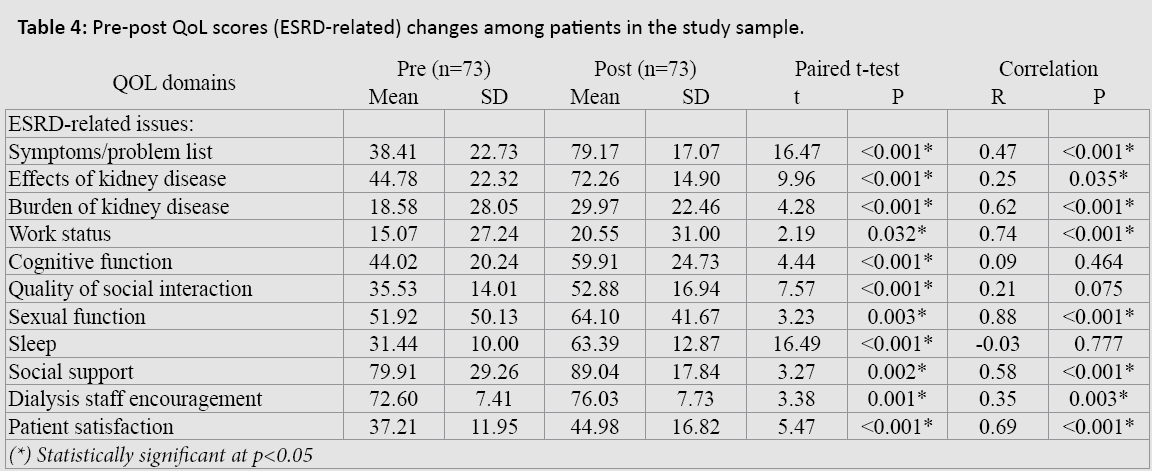
Concerning the pre and post program changes in the scores of QOL SF-36, Table 5 indicates statistically significant increases in the scores of all domains. The only exception was in the health change domain (p=0.321). Before the program, the lowest score was in the pain domain (17.77) while the highest was in health change domain (64.86). At the posttest, the domain with the lowest score was that of energy and fatigue (27.67) whereas the highest was that of social function (61.99). The table also demonstrates weak to strong statistically significant positive correlations between pre and post-program scores reaching 0.88 for the physical functioning domain. Only the scores of emotional wellbeing were not correlated.
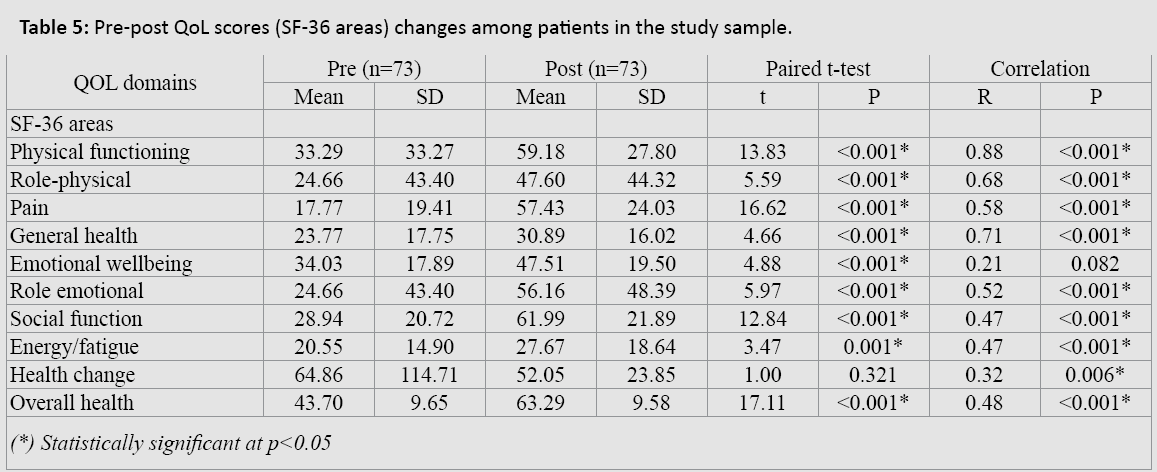
Table 6 illustrates statistically significant decreases in patients’ Borg scores throughout the three months of follow-up (p<0.001). Meanwhile, patients’ dry weight and weight gain did not show any changes of statistical significance throughout the months of follow-up.
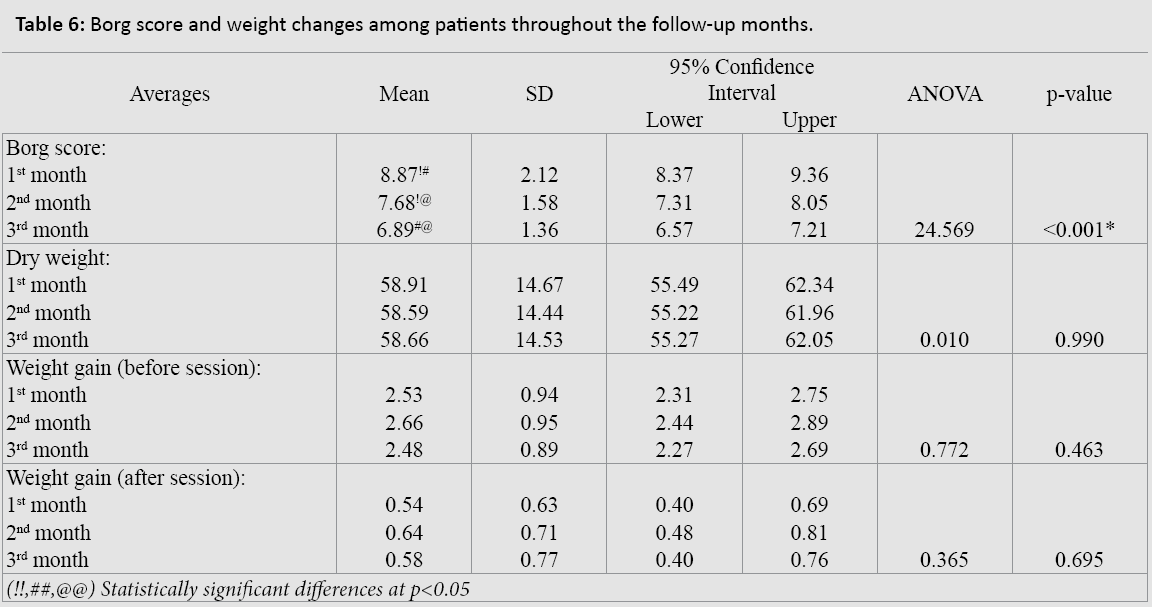
As regards patients’ vital signs during and after the sessions throughout the follow-up period, Table 7 indicates no statistically significant changes. However, there are consistent trends of decreases in both systolic and diastolic pressure from the first to the third months at all times of measurement.
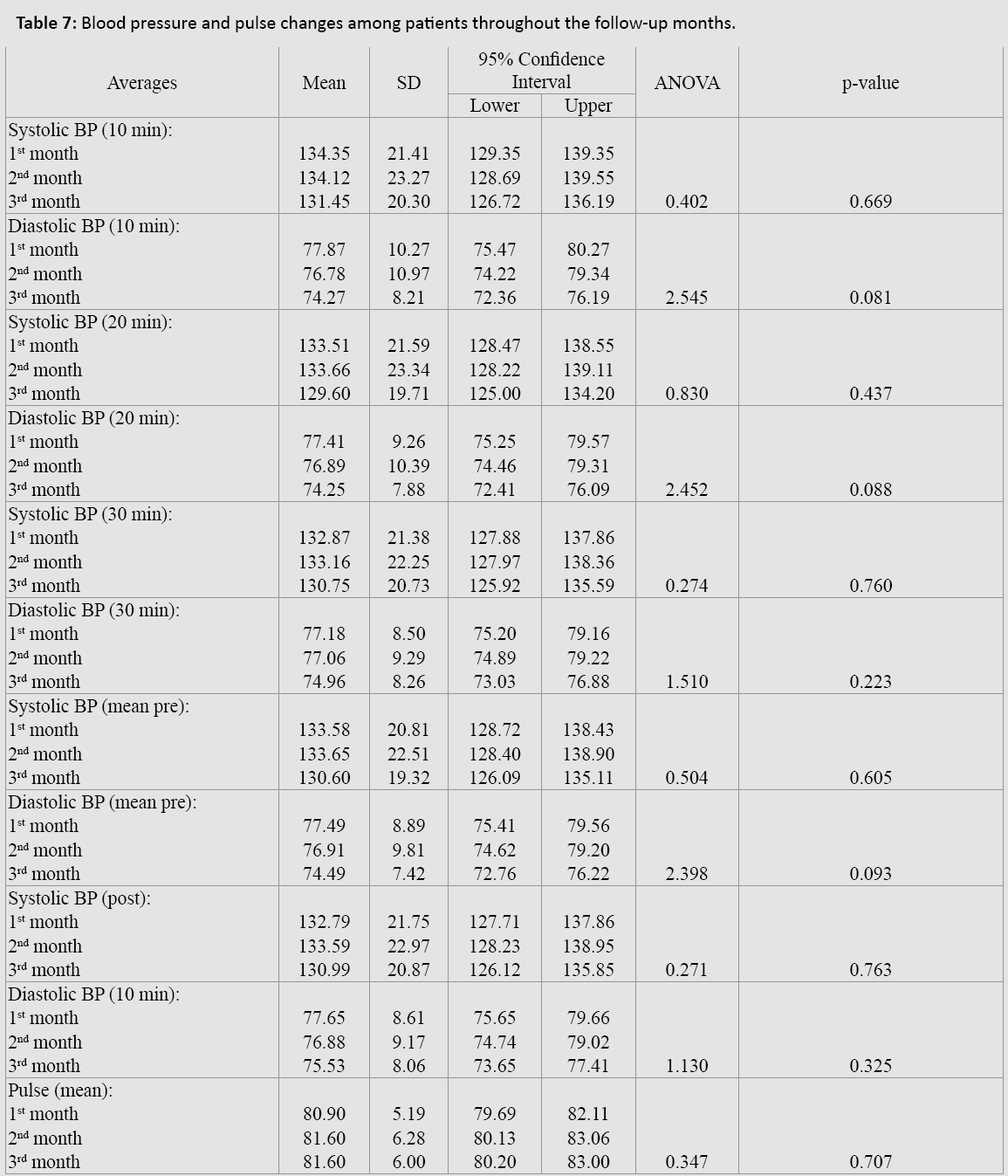
Table 8 demonstrates statistically significant improvements in the blood flow during the second and third months of followup in comparison with the first month (p> 0.001). Meanwhile, the duration of sessions did not change throughout the followup period.
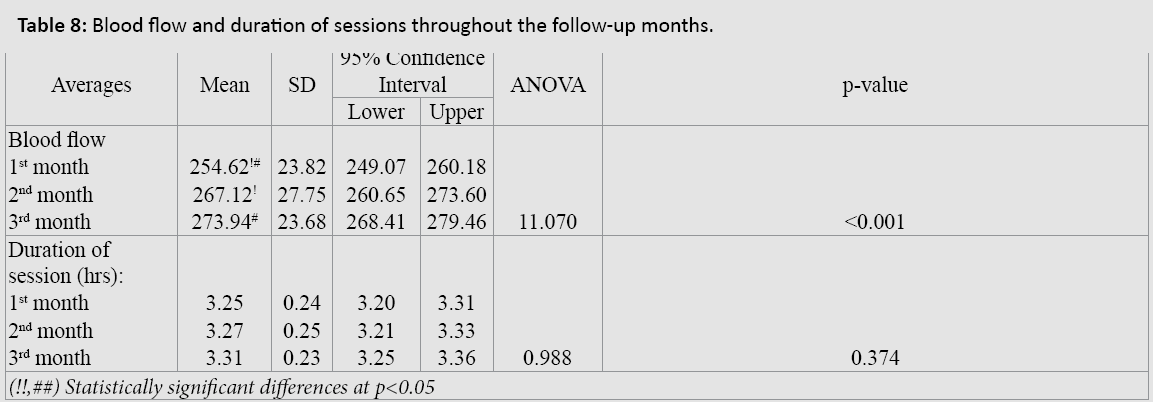
Table 9 demonstrates no changes in session duration throughout the follow-up months. Meanwhile, the percentages of patients with complications dropped from 60.3% in the first month to 6.8% in the third month, and this difference is statistically significant (p>0.001).

Figure 2: illustrates the changes in laboratory tests levels throughout the follow-up months. It demonstrates statistically significant improvements in the adequacy of dialysis (kt/v) and in serum potassium level (p<0.001) from the first to the third months. Although the percentages of patients with hemoglobin level 11 gm/dl or higher increased from 41.1% at the first month to 60.3% at the third month, the difference was not statistical significant (p=0.067).
The most recent study demonstrates substantially improvement in both physical function and mental well-being for a wide range of dialysis patients.[15] The benefits of exercise training has been well demonstrated in a range of disease conditions including ESRD and was recently highlighted by a systematic review in haemodialysis patients.[16]
Although there have been numerous recent studies on the benefits of exercise, few dialysis clinics or nephrologists provide encouragement of exercise programs as a part of routine care for their patients. Moreover adaptation of routine counseling and encouragement for physical activity has the potential to improve outcomes, improve physical functioning, and optimize quality of life and the overall health of dialysis patients.[17]
Similar to our study; a study done in the San Francisco Bay Area, the majority of whom were male, with a mean age of 60, started exercise programs and found the majority of participants strongly agreed that a sedentary lifestyle was a health risk (95%) and that increasing exercise was a benefit (98%). However, 92% of participants reported at least one barrier to physical activity. And most of them reported barriers were fatigue on dialysis days and shortness of breath (48%). Moreover a great number reported that barriers were associated with lower levels of physical activity.[1] Physical function limitation is a common disorder in patient on maintenance hemodialysis therapy as we mentioned before.
A similar study done in Tehran, Iran, applied an eight week intradialytic exercise program three times per week, which included stationary cycling at an intensity of 12-16 out of 20 at the rate of perceived exertion (RPE) of Borg scale. Fasting blood sampls for serum biochemistry were drawn, the age, HD duration, and activity scores were 51.6(18.9) yearrs; 25.1(13.9) months, and 19.2(7.6), respectively. Unfortunately, the physical exercise program had no influence on weight, KT/V values, serum urea, albumen, hemoglobin, or lipid levels.[18]
Bennett reported the concept of dialysis exercise adequacy and emphasized that increasing the exercise and activity of the dialysis population can decrease mortality, improve quality of life, improve physical function and decrease depression.[19] Moreover Song and Sohng; 2012 recommended that a progressive resistance training using elastic bands and sandbags can be utilized as part of a regular care plan for hemodialysis patients, and the benefits significantly improved the skeletal muscle mass, grip, leg muscle strength, and quality of life.[20]
Exercise might have beneficial effects on the quality of life of dialysis patients by improving mental and physical functions and contributions to maintain electrolyte balance. [21]
In the present study, patients appeared to enjoy doing the exercise. Some of them expressed comments such as "I feel better and healthier", "I can move and walk easy", "I can sleep and eat well", "I enjoyed the two months I spent exercising". All of these comments reflect our study results, whereas the pre and post program quality of life scores statistically improved in all domains.
Another recent study showed that resistance training increased strength and functional capacity in 10 medically stable hemodialysis patients (age, 42.8 +4.4 years). The results stated increases in the peak torque of quadriceps muscle, the distance covered during a 6-min walk test, maximal walking speed, and improved performance in a sit-to stand test. [22]
In a relevant study to evaluate exercise training in chronic kidney disease patients, researchers found that exercise training can increase exercise capacity, improve muscle strength and function, and decrease blood pressure.[16] Similar findings in an henrique et al; study, support our findings and explained that exercise programs significantly increase the distance walked and show a significant reduction in systolic blood pressure, and diastolic blood pressure.[23]
However, the impact of physical exercise on blood pressure levels reported a significant reduction in interdialytic systolic from 138.4(10.2) mmHg to 73.9 (11.8) and predialysis systolic blood pressure fell significantly during the training period, but returned to baseline level when exercise was discontinued.[24] Another interventional study had no significant changes in blood pressure levels.[25]
Regarding the effects of exercise programs on changes of laboratory tests; Persons et al; wished to determine if an eight week exercise program during dialysis sessions would increase urea removal with improvements in work performance and perception of quality of life and recommended that exercise during dialysis be performed during the first 2 hours of dialysis.26 Despite another interventional study shown after an 8-week intervention, significant improvements were seen in serum phosphate levels (decreased by 1.84 mg/dL) and serum potassium levels (decreased by 0.69 mg/dL). No side-effects were observed. Serum calcium and hemoglobin levels did not change significantly in the exercise group.[18] In the present study the laboratory test demonstrates statistically significant improvements in adequacy of dialysis, serum potassium levels and even hemoglobin levels.
Based on the main study findings it is concluded that the implementation of the exercise program was associated with significant improvements in the score of all domains of quality of life and statically significant changes in the scores of all activities when compared with the post physical fitness scale. There were also significant decreases in patients' Borg scores through the three months of follow up. In terms of the predictors of vital signs during and after the exercise program; there are consistent trends of decreases in both systolic and diastolic blood pressure. Meanwhile the percentage of patients with complications dropped from first month to at third month and the adequacy of dialysis was improved.
In the light of the study findings, the following is recommended:
• The developed exercise program for hemodialysis patients should be implemented on a wider scale and evaluated for further improvement.
• A simple manual of guidelines of exercise programs and the benefits on patients undergoing hemodialysis should be made available in all units to be provided to newly admitted patients.
• Patient QoL should be the main objective for nephrologists and nurses during the care of hemodialysis patients.
• The exercise program might be applied in other similar situations as on peritoneal dialysis patients, and evaluated for further improvement.
This research project (No: 030-11-MED-KKU) was supported by a grant from the Deanship of Scientific Research, King Khalid University.